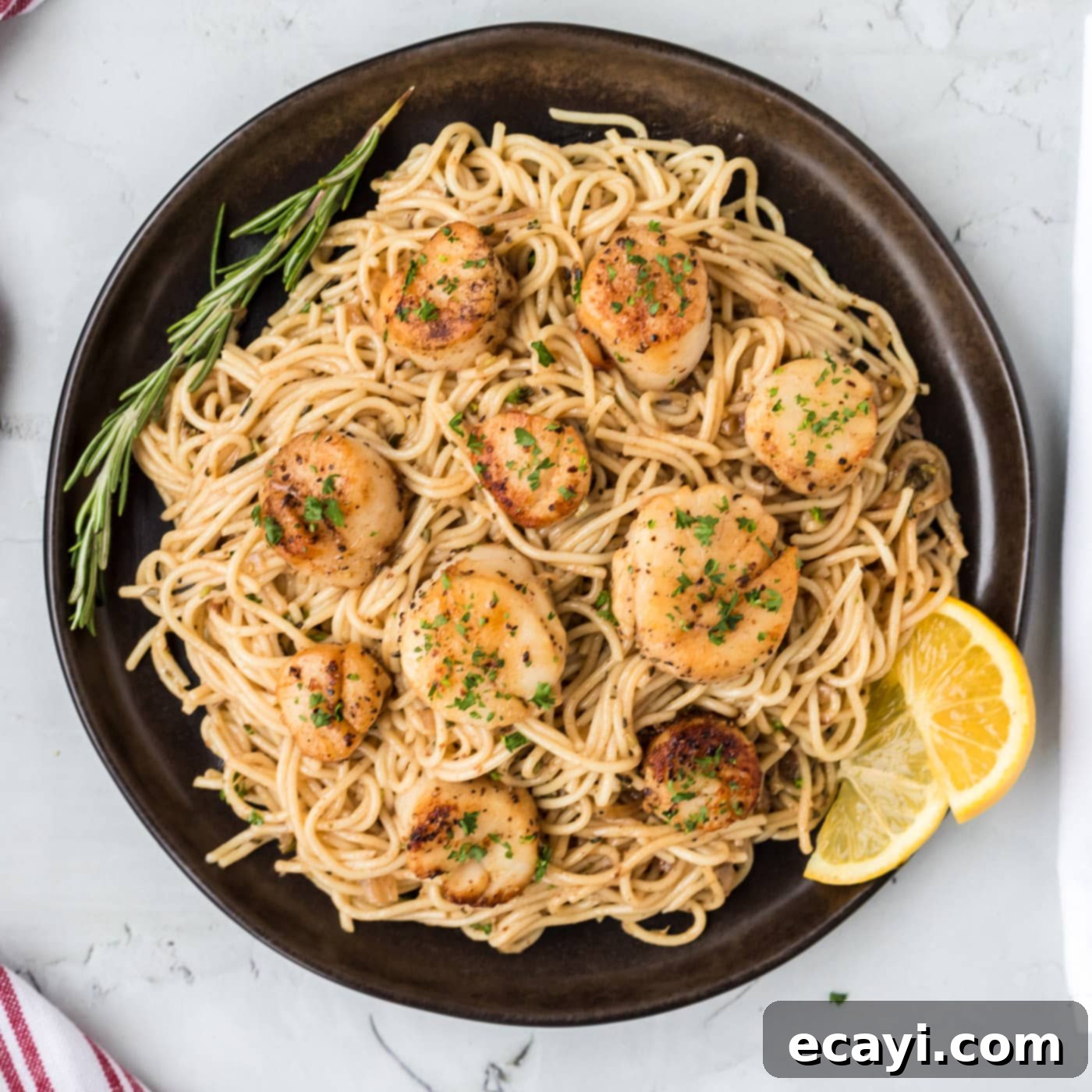Elegant Pan-Seared Scallop Pasta with White Wine Sauce – A 30-Minute Gourmet Meal
Indulge in a restaurant-quality meal right in your own kitchen with this exquisite Scallop Pasta recipe. Featuring perfectly pan-seared, golden-crusted scallops, delicate angel hair pasta, and a luxurious white wine sauce, this dish is a true culinary delight. Despite its impressive appearance and sophisticated flavors, this entire meal comes together in just 30 minutes, making it an ideal choice for busy weeknights or when you want to impress guests without spending hours in the kitchen.
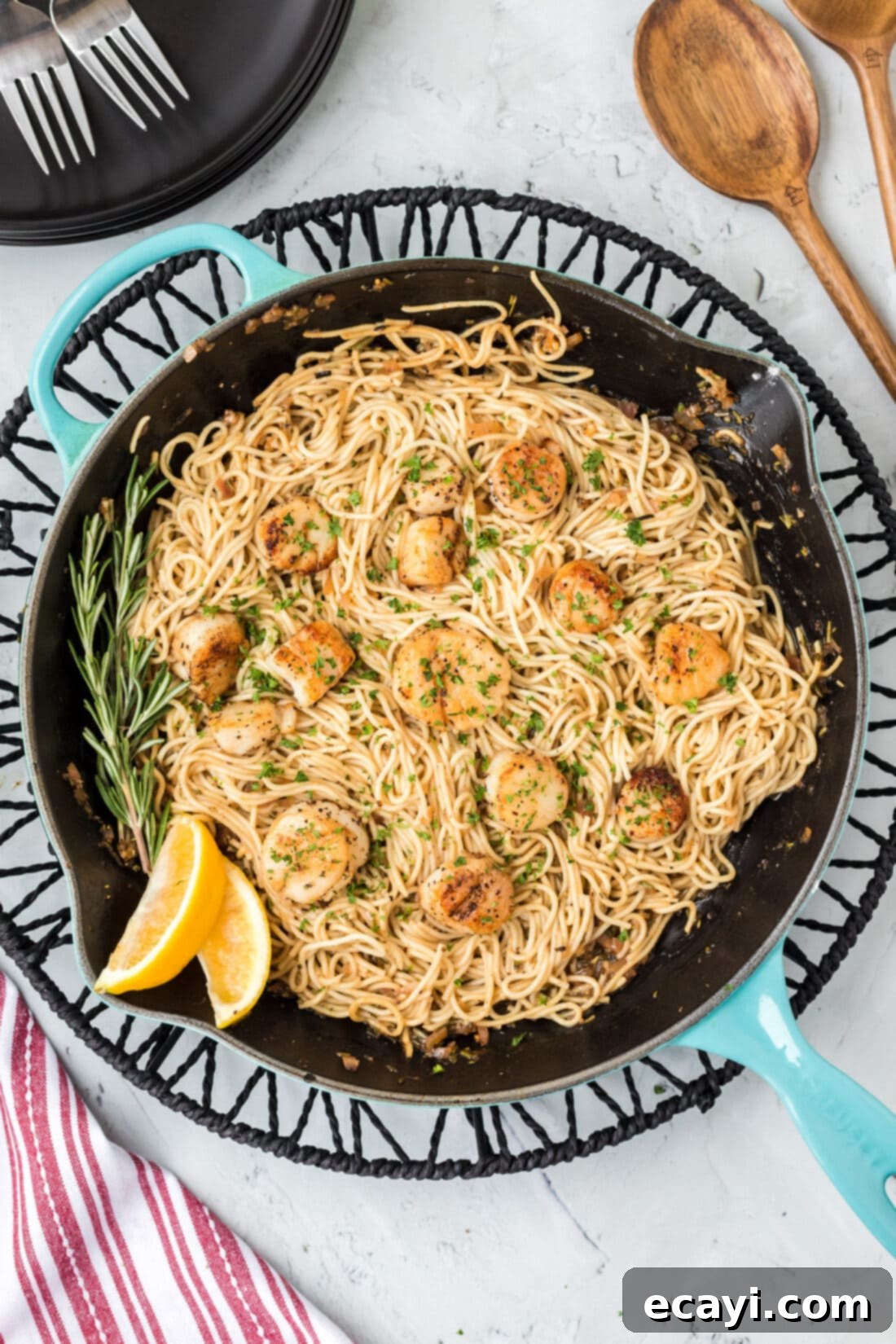
Why This Scallop Pasta Recipe Is a Must-Try
This scallop pasta recipe stands out for several compelling reasons. Scallops are inherently quick-cooking seafood, offering a delicate sweetness and tender texture that elevates any dish. When pan-seared correctly, they develop a beautiful golden crust, locking in their natural juices and creating a delightful contrast with the tender pasta. Unlike many complex seafood dishes, this recipe leverages the speed of scallop cooking to deliver a gourmet experience in minimal time. The real magic, however, lies in the elegant white wine sauce.
The sauce is a symphony of fresh, aromatic flavors. It’s built upon a foundation of crisp white wine, enriched by fragrant fresh rosemary, finely minced shallots, a bright squeeze of lemon juice, and a generous touch of grated Parmesan cheese. This combination creates a sauce that is both simple and profoundly rich, perfectly complementing the scallops without overpowering them. The subtle herbal notes of rosemary, the gentle oniony sweetness of shallots, and the tangy brightness of lemon cut through the richness of the butter and Parmesan, resulting in a perfectly balanced flavor profile that lingers on the palate. Whether you’re planning a classy dinner at home or entertaining discerning guests, this scallop pasta is guaranteed to be a showstopper that requires surprisingly little effort.
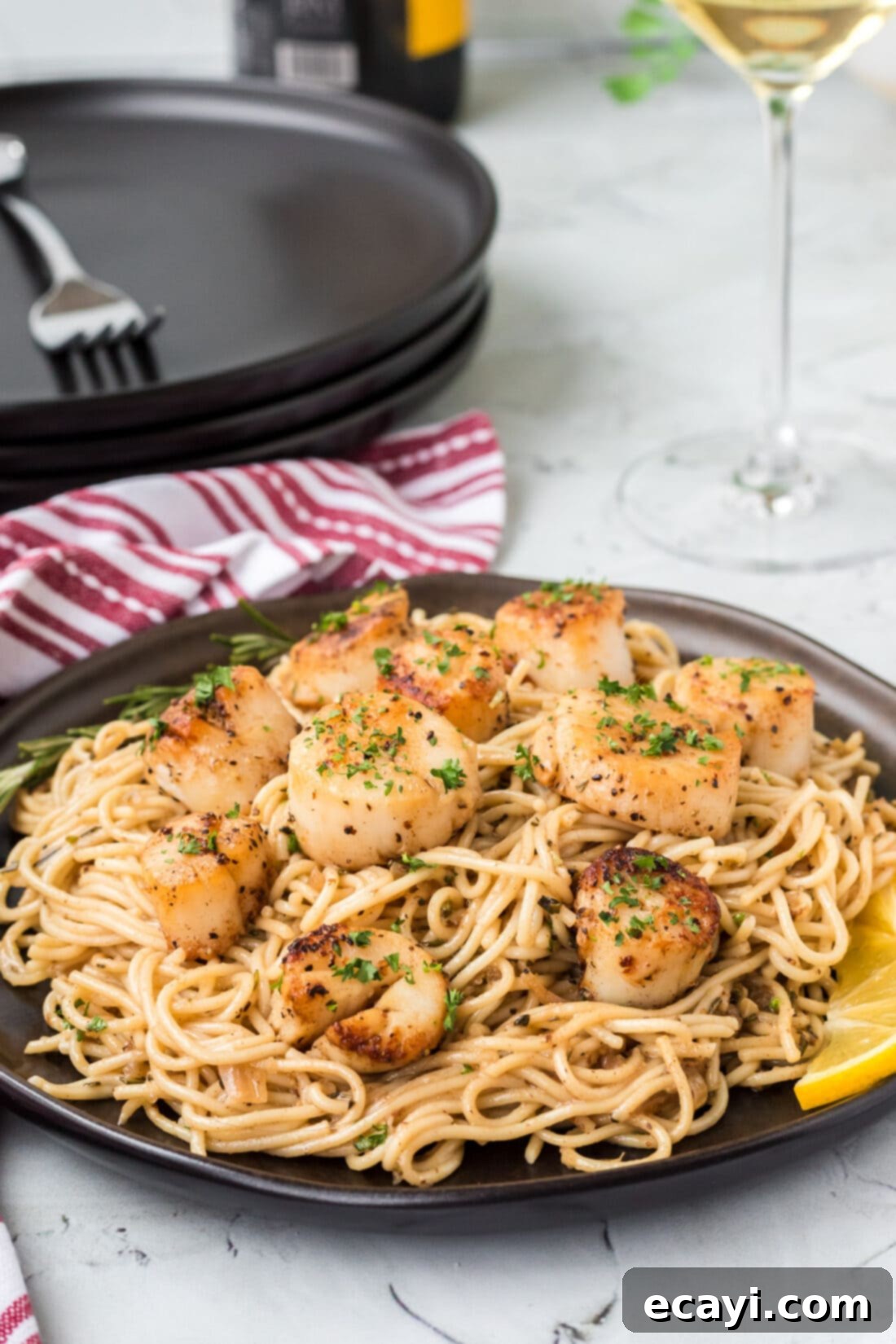
Key Ingredients for Your Gourmet Scallop Pasta
Crafting this delightful scallop pasta requires a few quality ingredients, most of which you might already have in your pantry or are easily found at your local grocery store. For precise measurements, detailed quantities, and complete instructions, refer to the printable recipe card available at the end of this comprehensive guide. Here’s a breakdown of what you’ll need to create this memorable dish:
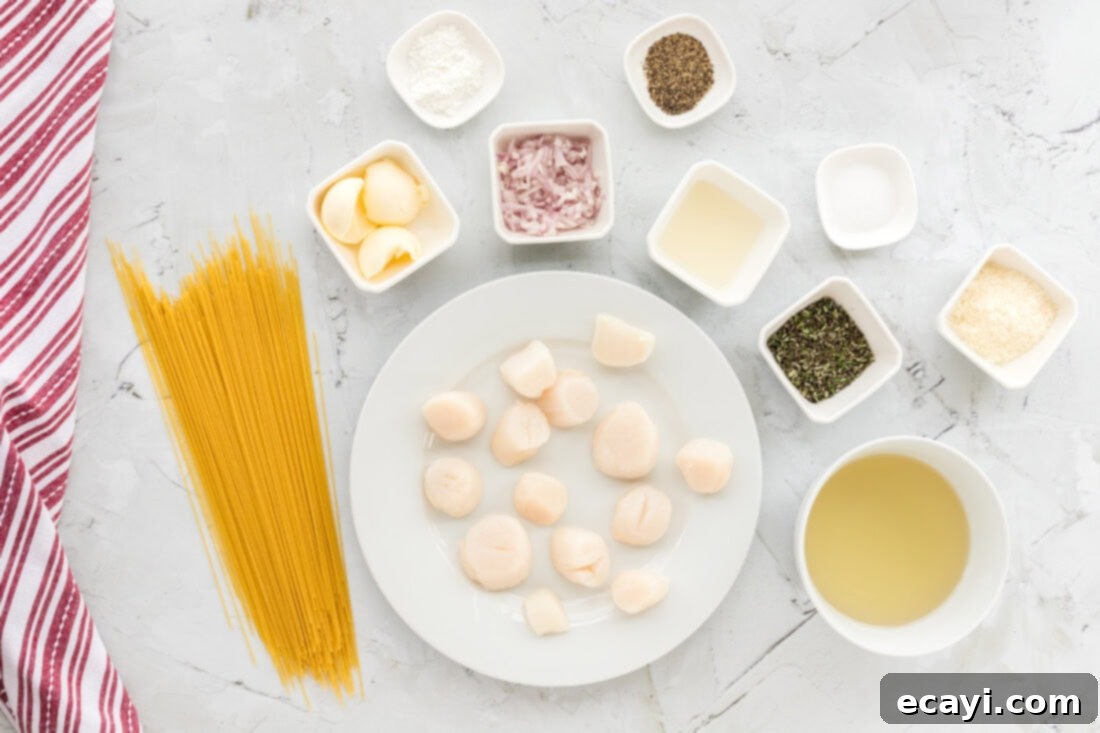
Ingredient Spotlight & Expert Substitution Tips
Understanding each ingredient’s role and knowing how to make smart substitutions can greatly enhance your cooking experience and results. Here’s a deeper dive into the components of this exquisite scallop pasta:
Choosing the Right Pasta
PASTA – For this elegant dish, the texture of the pasta is as important as its flavor. While angel hair pasta is traditionally recommended for its delicate strands that beautifully absorb the white wine sauce, you have several excellent options. Long, thin noodles like linguine or spaghetti also work wonderfully, providing a similar mouthfeel that allows the scallops to remain the star. If you prefer a slightly heartier noodle, fettuccine or even pappardelle could be used, though you might find they absorb a bit more sauce. The key is to select a pasta that won’t overwhelm the delicate scallops and sauce. Always cook your pasta al dente for the best texture.
Selecting and Preparing Scallops
SCALLOPS – The quality and preparation of your scallops are paramount to the success of this dish. It’s absolutely crucial to ensure the scallops are as dry as possible before cooking. Excess moisture will cause them to steam rather than sear, preventing that coveted golden-brown crust. When purchasing, look for “dry” sea scallops. “Wet” scallops are often treated with a sodium tripolyphosphate solution to preserve them, which causes them to absorb more water. This extra moisture makes it incredibly difficult to achieve a proper sear, resulting in a rubbery texture. Dry sea scallops, on the other hand, will sear beautifully, developing a sweet, caramelized exterior and a tender, juicy interior. Aim for medium to large sea scallops for the best pan-searing results.
Crafting the White Wine Sauce
WHITE WINE – The white wine forms the aromatic base of our sauce. Opt for a dry white wine such as Pinot Grigio, Sauvignon Blanc, or a dry unoaked Chardonnay. These wines offer a crisp acidity and subtle fruit notes that enhance the seafood without adding sweetness. Avoid sweet wines as they can alter the flavor profile significantly. If you prefer a non-alcoholic option, a good quality chicken or vegetable broth can be used, though it will yield a slightly different, less complex flavor. In this case, you might want to add a touch more lemon juice to compensate for the wine’s acidity.
BUTTER – Unsalted butter is preferred for searing and building the sauce, giving you complete control over the dish’s saltiness. The butter helps create that rich, velvety texture in the sauce and assists in achieving a beautiful golden crust on the scallops.
FRESH ROSEMARY & SHALLOTS – These aromatics are essential for the sauce’s depth of flavor. Fresh rosemary provides a distinct, fragrant herbal note, while minced shallots offer a milder, sweeter onion flavor than traditional onions, perfectly suiting the delicate scallops. If fresh rosemary isn’t available, a smaller amount of dried rosemary (about 1 teaspoon) can be used, or you could experiment with fresh thyme or finely chopped chives for a different aromatic twist. For shallots, if unavailable, a very small amount of finely minced red onion or half an onion sautéed longer to soften can be a substitute, but shallots truly offer the best flavor.
LEMON JUICE – Freshly squeezed lemon juice brightens the entire dish, cutting through the richness of the butter and Parmesan and enhancing the natural sweetness of the scallops. It’s a crucial component for balancing the flavors.
PARMESAN CHEESE – Grated Parmesan cheese adds a salty, umami depth to the sauce, making it incredibly savory and satisfying. Always use freshly grated Parmesan for the best flavor and texture; pre-grated cheeses often contain anti-caking agents that can make the sauce gritty.
CORNSTARCH – A small amount of cornstarch is used to gently thicken the white wine sauce, giving it a luscious consistency that clings beautifully to the pasta and scallops. You could substitute an equal amount of all-purpose flour, creating a slurry with a bit of cold water before adding it, but cornstarch tends to create a smoother, clearer sauce.
Step-by-Step Guide to Crafting Perfect Scallop Pasta
These step-by-step photos and instructions are here to help you visualize how to make this recipe. You can Jump to Recipe to get the printable version of this recipe, complete with measurements and instructions at the bottom.
- Prepare the Pasta: Begin by cooking your chosen pasta according to the package directions until it is al dente. This ensures the pasta retains a slight bite and doesn’t become mushy when tossed with the sauce. Once cooked, drain the pasta and rinse it briefly in cool water to halt the cooking process and prevent it from becoming sticky. Toss it lightly with a drizzle of olive oil, then set aside.
- Dry and Season Scallops: Pat your sea scallops thoroughly dry with paper towels. This step cannot be overstated, as dry scallops are essential for a perfect sear. Season them generously on all sides with salt and black pepper. Remember, you might not use all of your allotted salt and pepper for seasoning; adjust to your taste.
- Pan-Sear Scallops to Perfection: Melt 3 tablespoons of unsalted butter in a large skillet over medium-high heat until it becomes foamy. The foam indicates the butter is hot enough. Carefully place the seasoned scallops into the hot pan in a single layer, ensuring not to overcrowd the pan (cook in batches if necessary). Allow them to cook undisturbed for approximately 3-4 minutes per side, or until a beautiful golden-brown crust forms on each side. Overcooking scallops can make them tough, so watch them closely.
- Rest the Scallops: Once perfectly seared, remove the scallops from the pan and set them aside on a plate. They will finish cooking with the residual heat.
- Build the White Wine Sauce: Reduce the heat to medium. To the same skillet (don’t clean it, those browned bits are flavor!), add 1 cup of white wine, the remaining salt and pepper, chopped fresh rosemary, minced shallots, grated Parmesan cheese, and lemon juice. Bring the mixture to a gentle boil and let it simmer, stirring occasionally, until the liquid has reduced by half. As the sauce reduces, the flavors will concentrate, and you’ll notice the chopped ingredients becoming more prominent.
- Thicken the Sauce: Once the sauce has visibly reduced, sprinkle the cornstarch evenly over the liquid. Stir continuously until the mixture thickens to your desired consistency. The cornstarch will help the sauce beautifully coat the pasta and scallops.
- Combine and Serve: Remove the skillet from the heat. Add the cooked angel hair pasta to the sauce in the pan and toss gently to ensure every strand is coated. Carefully add the seared scallops back into the pan and gently toss everything together one last time. Serve immediately for the best experience.
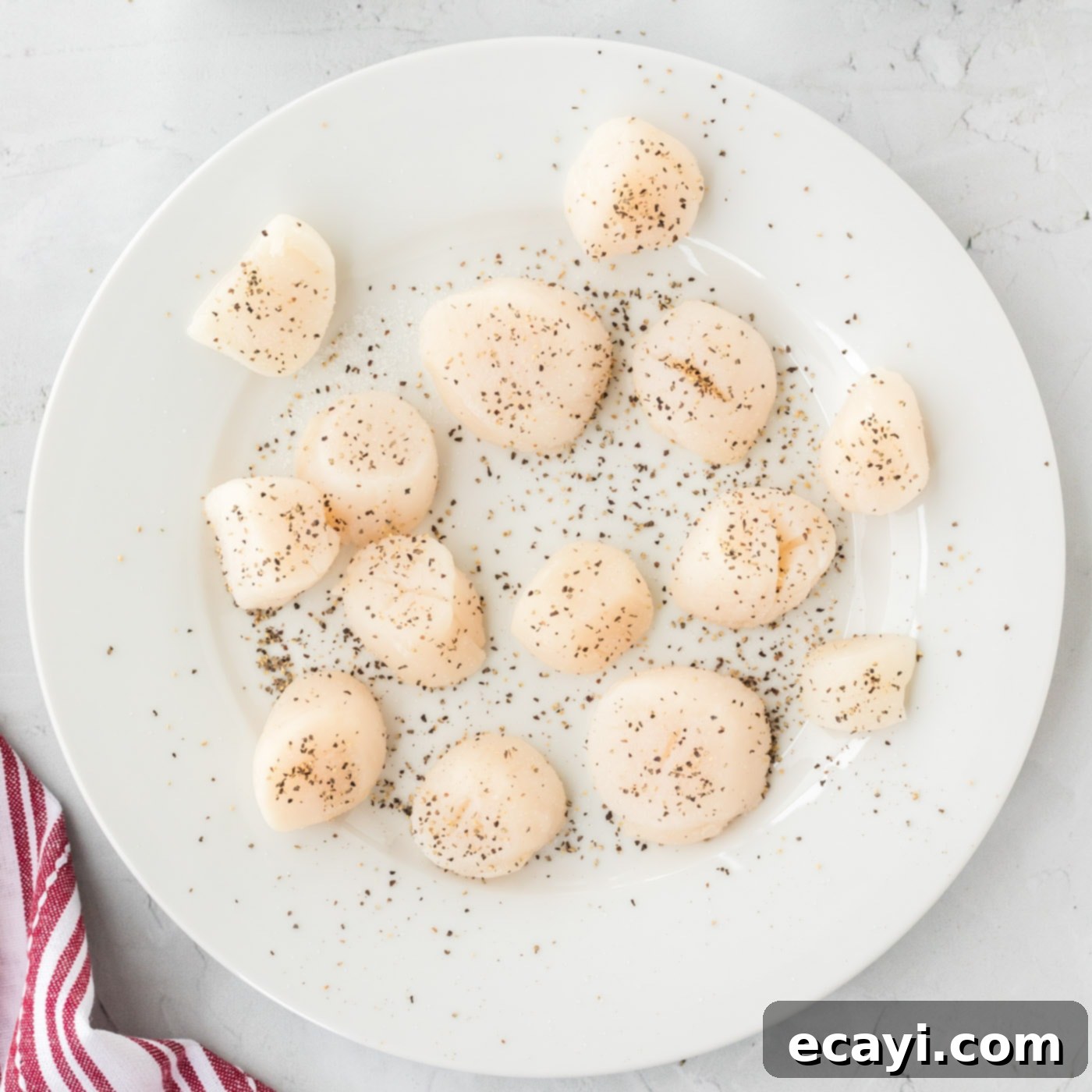
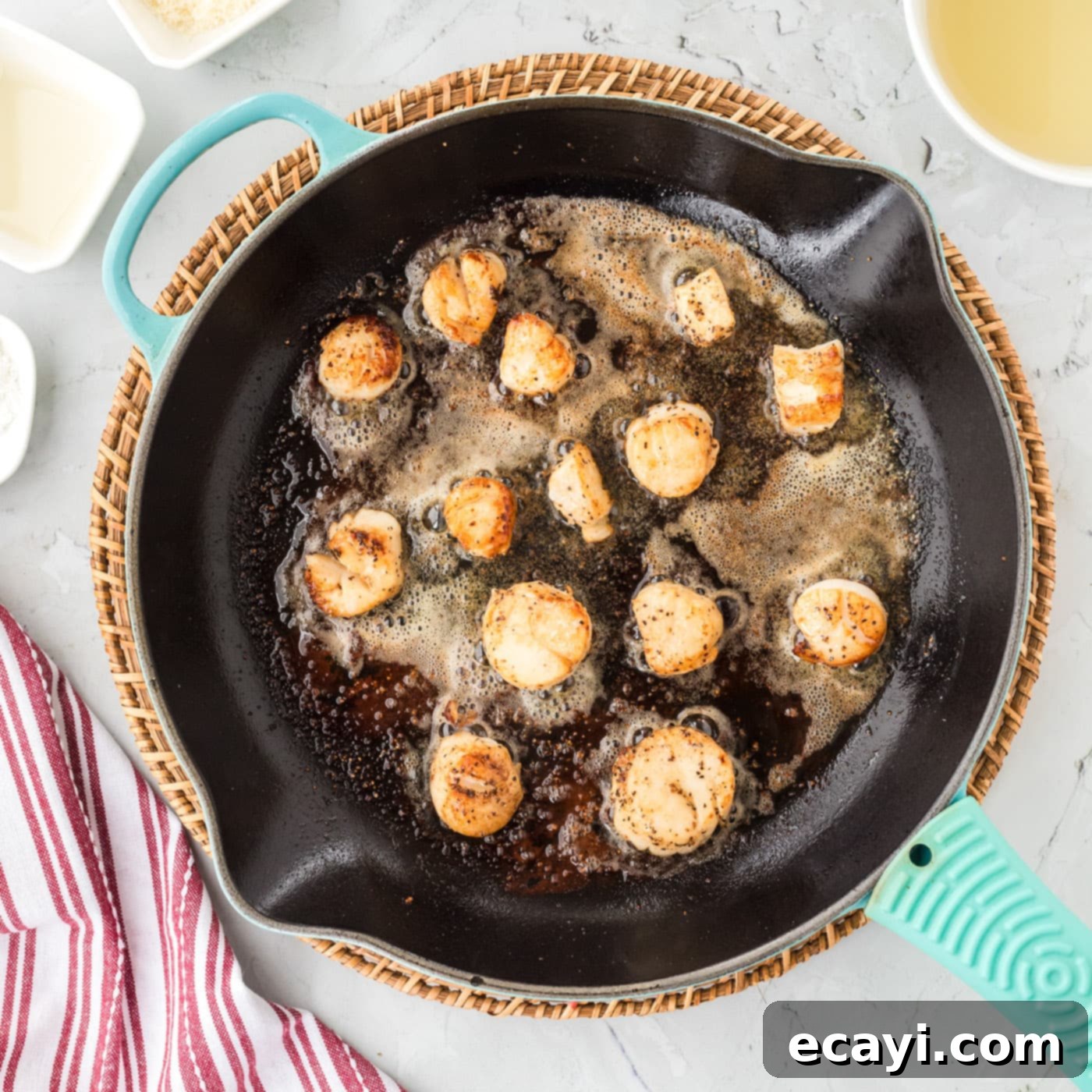
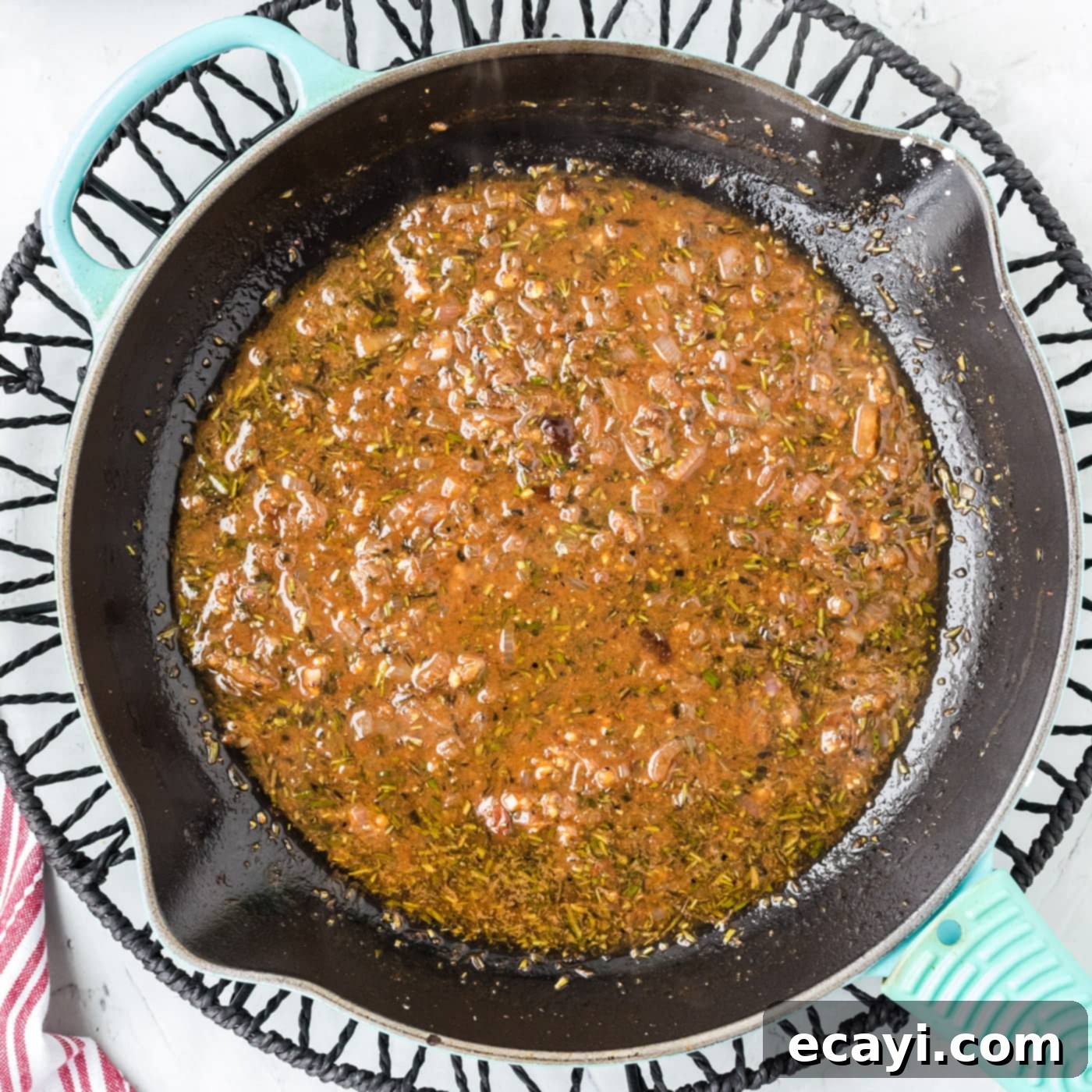
Frequently Asked Questions & Expert Tips for Scallop Pasta
As this dish prominently features delicate scallops, it’s truly best enjoyed immediately after preparation to experience their optimal texture and flavor. Scallops can become chewy and lose their tenderness upon refrigeration. However, if you do have leftovers, allow the dish to cool completely before transferring it to an airtight container. Store it in the refrigerator for no more than 1-2 days. While safe to consume for up to 3 days, the quality of the scallops will diminish. For reheating, gently warm the pasta in a skillet over low-medium heat. You may need to add a splash or two of water, chicken broth, or even white wine to reintroduce moisture and loosen the sauce, preventing it from drying out. Avoid high heat, as it can quickly overcook the scallops.
A heavy-bottomed skillet, such as a cast-iron pan or a stainless steel skillet, is ideal for searing scallops. These types of pans retain heat exceptionally well, ensuring an even and consistent sear that produces that desirable golden crust. Non-stick pans can work, but may not achieve the same level of caramelization.
The most common reasons for scallops failing to sear properly are: 1) They weren’t patted dry enough – moisture is the enemy of searing! 2) The pan wasn’t hot enough – ensure your skillet is smoking slightly before adding the scallops. 3) The pan was overcrowded – cook scallops in batches to maintain high heat and allow for proper air circulation, preventing them from steaming.
Absolutely! This scallop pasta is versatile. For added color, nutrients, and flavor, consider stirring in some fresh spinach or halved cherry tomatoes during the last minute or two of the sauce cooking time. Asparagus spears, peas, or thinly sliced zucchini would also make excellent additions. Just ensure any added vegetables are quick-cooking or pre-cooked to avoid overcooking the scallops.
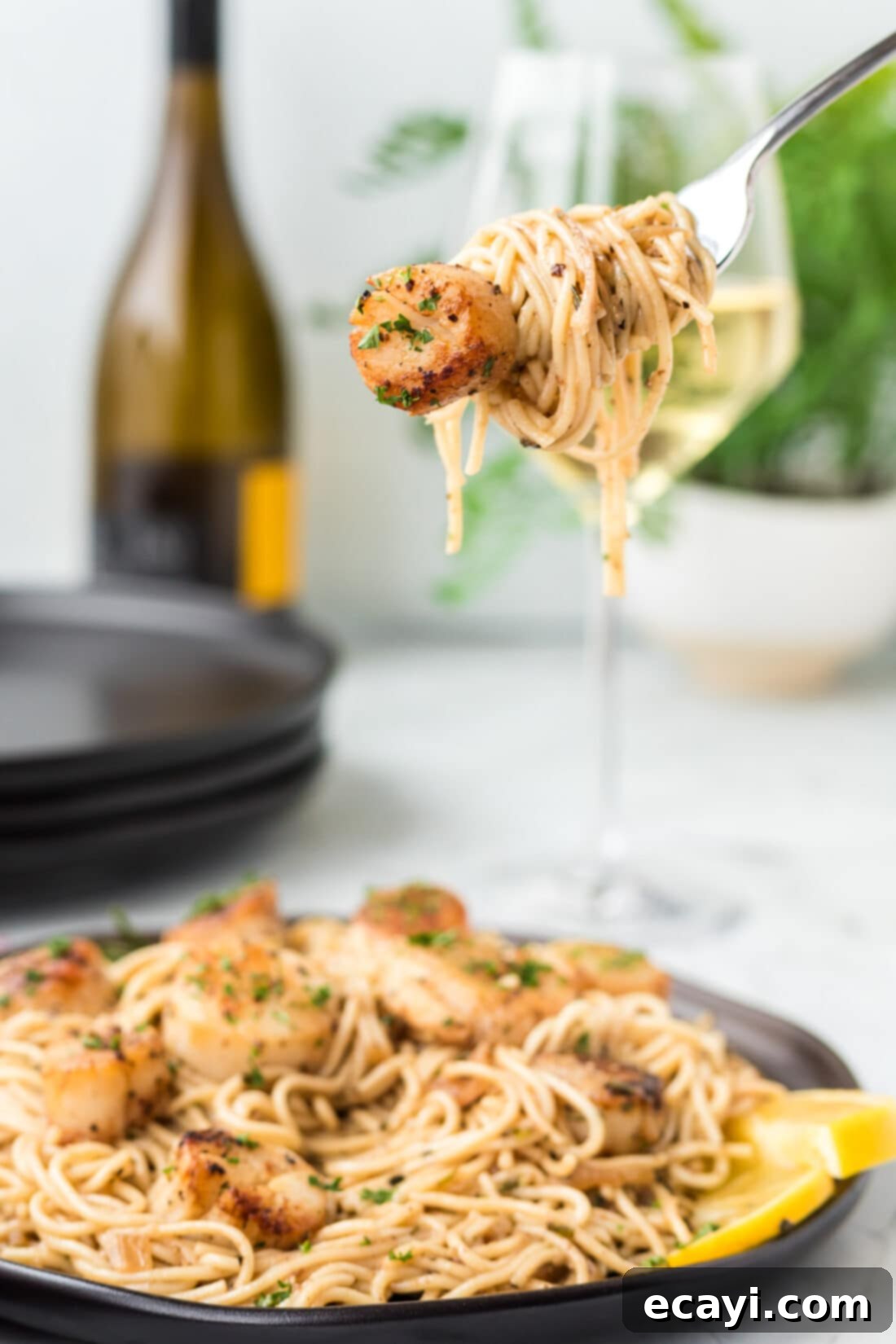
Elevate Your Meal: Serving Suggestions for Scallop Pasta
This scallop pasta is a complete and satisfying meal on its own, but pairing it with the right accompaniments can truly enhance the dining experience. For a harmonious pairing, serve your scallop pasta with a crisp, dry white wine like a Sauvignon Blanc or Pinot Grigio. The acidity of the wine beautifully complements the richness of the sauce and the sweetness of the scallops.
To round out the meal, consider serving a simple side dish. A light, fresh green salad with a vinaigrette dressing provides a refreshing contrast, while steamed or roasted vegetables like asparagus, green beans, or broccoli offer delightful texture and additional nutrients. Don’t forget a piece of warm, crusty bread to sop up every last bit of that delectable white wine sauce! For an extra touch of gourmet presentation, garnish your individual servings with a sprinkle of freshly grated Parmesan cheese and a dash of vibrant, chopped fresh parsley before serving. This dish is perfect for an intimate dinner for two or can be easily scaled up by simply doubling or tripling the recipe to entertain a larger group, making it a versatile choice for any occasion. Enjoy the elegant simplicity and incredible flavor!
Explore More Delicious Seafood Recipes
If you’re a lover of fresh seafood, we have an array of other fantastic recipes that are sure to tantalize your taste buds. From flaky fish to succulent shrimp and more, explore these other culinary adventures:
- Maple Soy Salmon: A perfect balance of sweet and savory.
- Honey Walnut Shrimp: Crispy, sweet, and incredibly satisfying.
- Steamed Lobster Tail: An impressive and luxurious dish made simple.
- Baked Orange Roughy: A light and flaky fish baked to perfection.
- Dungeness Crab Legs: A sweet and tender crab experience.
- Air Fryer Scallops: For a different take on perfectly cooked scallops with less oil.
I love to bake and cook and share my kitchen experience with all of you! Remembering to come back each day can be tough, that’s why I offer a convenient newsletter every time a new recipe posts. Simply subscribe and start receiving your free daily recipes!
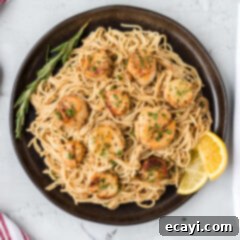
Scallop Pasta
IMPORTANT – There are often Frequently Asked Questions within the blog post that you may find helpful. Simply scroll back up to read them!
Print It
Pin It
Rate It
Save ItSaved!
Ingredients
- ¼ pound angel hair pasta
- ¾ pound sea scallops about 10 scallops
- 3 Tablespoons unsalted butter
- 1 teaspoon salt divided
- 1 teaspoon black pepper divided
Sauce
- 1 cup white wine
- 2 Tablespoons fresh rosemary chopped
- 2 Tablespoons shallots minced, about 1 small shallot
- 2 Tablespoons grated parmesan cheese
- 1 Tablespoon lemon juice
- ½ Tablespoon cornstarch
Things You’ll Need
-
Large skillet
-
Tongs
Before You Begin
- You can use any type of pasta such as linguini or spaghetti.
- For more color you can add some spinach and/or cherry tomatoes toward the end of the sauce cooking time.
- You will want to purchase sea scallops for this recipe. You may notice them labeled “wet” and “dry” at the grocery store. Wet scallops are soaked in a preservative to extend shelf life, but this causes the scallops to retain more moisture when cooked. We prefer to use dry sea scallops for this recipe.
Instructions
-
Cook the pasta according to package directions. Rinse in cool water to stop the cooking. Toss with a little olive oil to keep the pasta from sticking together and set aside.
-
Pat scallops dry and season to taste with salt and pepper. You won’t use it all. It’s important to make sure the scallops are dry. If they are wet they will steam when cooked and won’t brown properly.
-
Melt butter in skillet over medium-high until foamy. Add scallops to the pan and allow to cook undisturbed for about 6 minutes or until they are nicely browned on one side. Turn over and cook another 5-6 minutes.
-
Remove scallops from pan and set aside
-
Reduce heat to medium. Add wine, remaining salt and pepper, rosemary, shallots, parmesan, and lemon juice to the pan. Cook over medium on a gentle boil until reduced by half. You will begin to see the chopped ingredients in the pan more as the liquid reduces.
-
Once reduced, sprinkle cornstarch over the liquid and stir occasionally until mixture thickens.
-
Remove from heat. Add cooked angel hair pasta to the sauce in the pan and toss to coat. Add scallops back to pan and gently toss.
Nutrition
The recipes on this blog are tested with a conventional gas oven and gas stovetop. It’s important to note that some ovens, especially as they age, can cook and bake inconsistently. Using an inexpensive oven thermometer can assure you that your oven is truly heating to the proper temperature. If you use a toaster oven or countertop oven, please keep in mind that they may not distribute heat the same as a conventional full sized oven and you may need to adjust your cooking/baking times. In the case of recipes made with a pressure cooker, air fryer, slow cooker, or other appliance, a link to the appliances we use is listed within each respective recipe. For baking recipes where measurements are given by weight, please note that results may not be the same if cups are used instead, and we can’t guarantee success with that method.
